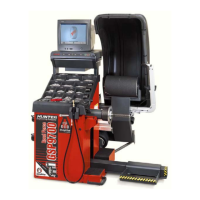74 4. Balancing a Wheel GSP9700 Series Road Force Measurement System Operation
Vehicle Plan View
The vehicle plan view provides a graphic depiction of the information that is gathered
by the GSP9700 during a loaded spin.
Net Tire Pull Arrow
Net pull indicates the direction and the magnitude of pull, due to the tires, that the
vehicle will be subject to, if the tire/wheel assemblies are mounted on the vehicle as
currently shown on the screen. Direction will be to the right (plus), or to the left
(minus), and further indicated by an arrow. Magnitude is measured in pounds (lbs) or
Newtons (N) and is further indicated by the length of the directional arrow.
While on the Vehicle Plan View, pressing
from the lower row of softkeys will
keep the same amount of lateral pull, but reverse the direction. This is accomplished
by swapping the positions of the two front tire/wheel assemblies. By default, lateral
pull is set to the left to offset road crown. Each press of
will toggle the pull to
the opposite direction, however it will remain in that direction until
is pressed
again.
Road Force Arrows
Road force indicates the amount of vertical (radial) Road Force variation remaining
in the tire/wheel assembly after ForceMatching™. Refer to “ForceMatching™,” page
61. Magnitude is measured in pounds (lbs), Newtons (N), or kilograms (kg). To
minimize vibration, the tire/wheel assembly with the largest amount of road force is
typically positioned farthest away from the driver (right rear). Even though the front
(steer) axle tires may be switched to change the direction of net pull, the rear
tire/wheel assembly with the largest amount of road force will still be positioned
farthest away from the driver.

